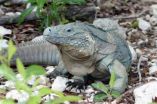(Press-News.org) CAMBRIDGE, Mass. -- The next time you're outdoors, see if you can spot the tallest tree. If you're in the desert Southwest, this may be an easy task — trees there are few and far between, and tend to hunch low to the ground to conserve resources. In the temperate Northeast, dense forests make the exercise a bit more difficult. And in the rainy Northwest, the towering stands of sequoias often reach higher than the eye can estimate.
Knowing how tall trees can grow in any given region can give ecologists a wealth of information, from the potential density of a forest and size of its tree canopy to the amount of carbon stored in woodlands and the overall health of an ecosystem. Now an MIT researcher, along with colleagues at the University of Maryland and the Santa Fe Institute in New Mexico, has come up with a simple model to predict the maximum tree height in different environments across the United States. The researchers' results have been published in the journal PLoS One.
The model takes in basic meteorological data — such as average annual temperature, precipitation, humidity and solar radiation — and computes how tall a tree is likely to grow under those conditions. The concept sounds simple enough, but lead author Chris Kempes, a PhD student in MIT's Department of Earth, Atmospheric and Planetary Sciences, says it took an understanding of plant mechanics, as well as fractal geometry, to accurately link tree height with meteorology.
"The branches of a tree really form a fractal, where if you cut off one of the limbs … and blow it up to the size of the tree, it'll look like the whole tree," Kempes says. "If you nail down that network structure correctly, then you can use it to predict how things change with size."
Kempes describes a tree's network as a vascular "highway system" of xylem and phloem that pumps water and nutrients from the soil up to the leaves, which in turn transport the sugary byproducts of photosynthesis back down to the roots. This pumping capacity, or fluid flow rate, is a bit of a balancing act: Trees of a given size have certain rates of metabolism that pump enough water and nutrients to survive without using up all of the available resources, such as light and water.
The team drew up an "idealized tree" to represent an average model of all tree species in the United States and developed equations to represent the relationships between fluid flow rate, tree size, and meteorological factors such as average temperature, rainfall, humidity and sunlight.
Putting their model to work, the group predicted the height of the tallest trees across the country, using local meteorological data. Kempes compared the team's results with actual measurements from the United States Forest Service. The predictions from the model matched up well with the Forest Service data, except for two geographic regions: the arid Southwest and parts of New England.
In the Southwest, the team found that trees actually grew taller than the model predicted, possibly due to evolutionary adaptation. "Deserts are where you find many specialized trait adaptations," Kempes says. "This is where you have weird traits that can deal with harsh environments."
In New England, trees were a bit shorter than predicted, primarily because the model did not factor in the area's timber and logging history. New-growth forests simply haven't had time to recover, but if left undisturbed, Kempes says they will eventually catch up with the model's predictions.
The group used the same model to predict what would happen to tree height in the event of global temperature changes, and found that with an increase of 2 degrees Celsius across the country, the average height of the tallest trees would shrink by 11 percent. Conversely, a dip of 2 degrees Celsius would spur trees to sprout up by 13 percent.
Going forward, Kempes and his colleagues plan to use the model to "see the forest from the tree," using maximum-tree-height data to extrapolate the heights of other, smaller trees in the forest. They also plan to adapt the model to predict the potential heights of different species of trees; the current model is based on an idealized, or universal, tree structure. Kempes says the team will study traits from different species to draw up a model that predicts which species live where.
"If you take a really small juniper tree that lives in the desert and you put it in the Northwest, it'll grow to perhaps four times as tall," Kempes says. "But it won't grow to be the height of a redwood. And this is what all of ecology is interested in: How much of your existence is determined by the environment versus your genetics? Now we can concretely say this is the environmental side of things, and now we want to go after the species."
###
Other authors of the paper include Geoffrey West, Distinguished Professor and past president of the Santa Fe Institute, and Michelle Girvan, assistant professor of electronics and applied physics at the University of Maryland.
Written by Jennifer Chu
MIT: The tallest tree in the land
New model predicts maximum tree height across the United States; gives information about forest density, carbon storage
2011-07-19
ELSE PRESS RELEASES FROM THIS DATE:
Face value
2011-07-19
CAMBRIDGE, Mass. -- The looks of political candidates are a key factor influencing voters, a phenomenon identified by a number of scholars in recent years. Now, a new study by MIT political scientists adds to this body of research by detailing which types of citizens are most influenced by candidate appearances, and why: The tendency is most prevalent among low-information voters who watch a lot of television.
Using data from the 2006 U.S. Senate and governors' races, the study shows that for every 10-point increase in the advantage a candidate has when rated by voters ...
John Theurer Cancer Center researchers shared 14 leading edge studies at recent ASCO meeting
2011-07-19
HACKENSACK, N.J. (July 18, 2011) — Researchers from the John Theurer Cancer Center at Hackensack University Medical Center presented results from 14 cancer-related studies during the recently concluded American Society of Clinical Oncology (ASCO) Annual Meeting, which took place June 3 – 7, 2011 in Chicago. The studies examined new cancer treatments, ways to predict the best treatment outcomes, and patient quality of life issues.
"ASCO is a great venue for sharing best practices and learning about new treatment approaches – we are proud to help contribute by presenting ...
Click chemistry with copper -- a biocompatible version
2011-07-19
Biomolecular imaging can reveal a great deal of information about the inner workings of cells and one of the most attractive targets for imaging are glycans – sugars that are ubiquitous to living organisms and abundant on cell surfaces. Imaging a glycan requires that it be tagged or labeled. One of the best techniques for doing this is a technique called click chemistry. The original version of click chemistry could only be used on cells in vitro, not in living organisms, because the technique involved catalysis with copper, which is toxic at high micromolar concentrations. ...
Cancer stem cells recruit normal stem cells to fuel ovarian cancer, U-M study finds
2011-07-19
ANN ARBOR, Mich. — Researchers at the University of Michigan Comprehensive Cancer Center have found that a type of normal stem cell fuels ovarian cancer by encouraging cancer stem cells to grow.
Cancer stem cells are the small number of cells in a tumor that drive its growth and spread. Traditional cancer treatments do not kill these cells, which is why cancer treatments often fail.
In a study published online in the Journal of Clinical Investigation, researchers looked in ovarian tissue at the mesenchymal stem cells, which are normal cells found throughout the body. ...
New therapy provides hope for millions of people suffering from bowel incontinence
2011-07-19
CHICAGO- A new procedure is now available for the treatment of chronic bowel incontinence, a disorder impacting the lives of more than 18 million Americans. The treatment, called InterStim® Therapy is a minimally invasive procedure which uses electrical impulses to stimulate the sacral nerve and improve muscle function. It is one of the only effective long-term treatments for bowel incontinence available to patients and Northwestern Memorial Hospital is one of the first medical centers in the country to offer the procedure.
"Bowel control problems can have a significant, ...
Research identifies genes vital to preventing childhood leukemia
2011-07-19
Researchers at The University of Western Ontario have identified genes that may be important for preventing childhood leukemia. Acute lymphoblastic leukemia (ALL) is a cancer of the blood that occurs primarily in young children. It's frequently associated with mutations or chromosomal abnormalities that arise during embryonic or fetal development. Working with mice, researchers led by Rodney DeKoter identified two key genes that appear essential in the prevention of B cell ALL, the most common form of ALL in children. The study is published online in Blood, the Journal ...
Grand Cayman blue iguana: Back from the brink of extinction
2011-07-19
While thousands of species are threatened with extinction around the globe, efforts to save the Grand Cayman blue iguana represent a rarity in conservation: a chance for complete recovery, according to health experts from the Wildlife Conservation Society's Bronx Zoo and other members of the Blue Iguana Recovery Program.
Coordinated by the National Trust for the Cayman Islands, the Blue Iguana Recovery Program—a consortium of local and international partners—has successfully released more than 500 captive-bred reptiles since the initiative's inception in 2002, when the ...
Preschool-age kids in different countries improve academically using self-regulation game
2011-07-19
Children who regularly participated in a Simon Says-type game designed to improve self-regulation – called the Head-Toes-Knees-Shoulders task – may have better math and early literacy scores.
The study found that the higher academic outcomes associated with the game, which emphasizes careful listening and following instructions, does not just benefit students in the United States, but also benefits children tested in Taiwan, China and South Korea.
More than 800 preschool age children ages 3-6 years old in the four countries participated in the study, which was just ...
IADR/AADR publish study on use of Twitter for public health surveillance of dental pain
2011-07-19
Alexandria, VA, USA – The microblogging service Twitter is a new means for the public to communicate health concerns and could afford health care professionals new ways to communicate with patients. With the growing ubiquity of user-generated online content via social networking Web sites such as Twitter, it is clear we are experiencing a revolution in communication and information sharing. In a study titled "Public Health Surveillance of Dental Pain via Twitter," published in the Journal of Dental Research—the official publication of the International and American Associations ...
Solar Panels Keep Buildings Cool
2011-07-19
Those solar panels on top of your roof aren't just providing clean power; they are cooling your house, or your workplace, too, according to a team of researchers led by Jan Kleissl, a professor of environmental engineering at the UC San Diego Jacobs School of Engineering.
In a study in an upcoming issue of the journal Solar Energy, Kleissl and his team published what they believe are the first peer-reviewed measurements of the cooling benefits provided by solar photovoltaic panels. Using thermal imaging, researchers determined that during the day, a building's ceiling ...
LAST 30 PRESS RELEASES:
Heart-brain connection: international study reveals the role of the vagus nerve in keeping the heart young
Researchers identify Rb1 as a predictive biomarker for a new therapeutic strategy in some breast cancers
Survey reveals ethical gaps slowing AI adoption in pediatric surgery
Stimulant ADHD medications work differently than thought
AI overestimates how smart people are, according to HSE economists
HSE researchers create genome-wide map of quadruplexes
Scientists boost cell "powerhouses" to burn more calories
Automatic label checking: The missing step in making reliable medical AI
Low daily alcohol intake linked to 50% heightened mouth cancer risk in India
American Meteorological Society announces Rick Spinrad as 2026 President-Elect
Biomass-based carbon capture spotlighted in newly released global climate webinar recording
Illuminating invisible nano pollutants: advanced bioimaging tracks the full journey of emerging nanoscale contaminants in living systems
How does age affect recovery from spinal cord injury?
Novel AI tool offers prognosis for patients with head and neck cancer
Fathers’ microplastic exposure tied to their children’s metabolic problems
Research validates laboratory model for studying high-grade serous ovarian cancer
SIR 2026 delivers transformative breakthroughs in minimally invasive medicine to improve patient care
Stem Cell Reports most downloaded papers of 2025 highlight the breadth and impact of stem cell research
Oxford-led study estimates NHS spends around 3% of its primary and secondary care budget on the health impacts of heat and cold in England
A researcher’s long quest leads to a smart composite breakthrough
Urban wild bees act as “microbial sensors” of city health.
New study finds where you live affects recovery after a hip fracture
Forecasting the impact of fully automated vehicle adoption on US road traffic injuries
Alcohol-related hospitalizations from 2016 to 2022
Semaglutide and hospitalizations in patients with obesity and established cardiovascular disease
Researchers ‘listen in’ to embryo-mother interactions during implantation using a culture system replicating the womb lining
How changing your diet could help save the world
How to make AI truly scalable and reliable for real-time traffic assignment?
Beyond fragmented markets: A new framework for efficient and stable ride-pooling
Can shape priors make road perception more reliable for autonomous driving?
[Press-News.org] MIT: The tallest tree in the landNew model predicts maximum tree height across the United States; gives information about forest density, carbon storage




